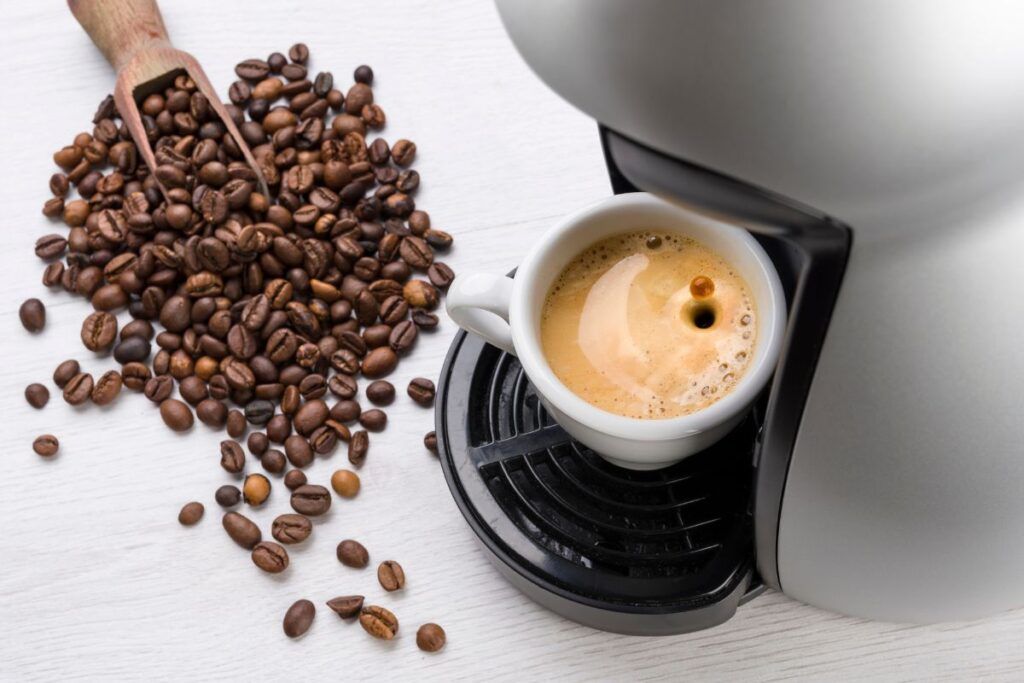When you wake up fresh in the morning to start a day with a hot cup of coffee, dealing with a coffee maker that drips the coffee extremely slowly will be disappointing. If you don’t want to face this issue anymore, this article is for you.
Your coffee maker might be dripping slowly because of the mineral deposit in the tubes and the machine’s interior. Descale this with vinegar and water. Adding too much coffee or packing it too tightly in the filter basket can also clog the filter basket holes and slow the flow of coffee.
This article will help you understand why your coffee maker drips slowly. You will also know the steps to fix the issue at the end of the article. So, keep reading.

Check out our list of top-handpicked products for all your electrical, appliance, and HVAC system needs to keep your home running smoothly.
This post includes some affiliate links.How long should a coffee maker take to drip?
A coffee maker will take 30 to 40 seconds to drip a cup.
The coffee maker is probably slow if the drip takes more than 40 seconds.
I drink coffee every morning.
And it was frustrating to deal with a coffee maker dripping slowly.
Changing the entire coffee maker is not always necessary.
I found a few solutions to fix this, which I share in this article.
Why is my coffee maker dripping slowly? (+Quick fix)
If your coffee maker is dripping slowly, you don’t need to replace the coffee maker, as I mentioned earlier.
Here are the 4 common reasons why your coffee maker might be dripping slowly.
1. Mineral buildup in your coffee maker
If you use hard water to make coffee, a mineral deposition will occur in the long run and block the water’s flow.
I know how annoying it feels when the coffee maker drips too slowly.
Hard water contains minerals like magnesium bicarbonate, calcium, carbonates, and sulfates.
These minerals will start to deposit at the surface of the coffee maker.
These mineral buildups affect the coffee maker’s efficiency and the quality of the coffee it produces.
Some of the problems caused by the mineral buildup are:
These mineral deposits reach the coffee maker’s water supply lines, blocking the water’s easy flow.
As the efficiency of the coffee maker is reduced due to the mineral deposition, it won’t bring the required temperature to extract the flavor from the coffee beans.
It will also produce warm coffee instead of steamy hot coffee.
You can fix this issue by descaling the mineral deposition as soon as you notice the white residue within the tubes and the interior of the coffee maker.
Follow this step-by-step method to dissolve the mineral deposition in your coffee maker:
- Get the materials you need to descale the coffee maker. Take water and vinegar. Depending on the mineral buildup in your coffee maker, you can measure how much vinegar you need to descale it.
- Now separate the carafe of your coffee maker to run it under the tap water to wipe out any leftover coffee deposits in the coffee maker.
- Fill the carafe with the vinegar until it is half full, then dilute it with the water until it reaches the end of the carafe. For example, if you have 4 cups of the carafe, add 2 cups of distilled vinegar and an equal amount of water.
- Attach the filter with the coffee maker, and add some more vinegar into the reservoir. Follow the exact step while making the coffee and switch on the coffee maker.
- While doing this step, vinegar will distribute throughout the machine, dissolve the mineral buildup, and remove it effectively.
- Run the vinegar water cycle as often as required depending on the mineral buildup in your coffee maker.
- After this treatment, throw out all the vinegar water in the coffee maker.
- Finally, run the machine with the normal water to get rid of the remaining vinegar.
- If you still find the mineral deposit stubborn inside the coffee maker even after this treatment, follow the steps given below.
- If your coffee maker has a stubborn mineral buildup, you must let the vinegar soak in the coffee maker for a certain period.
- Fill the carafe with the vinegar and the reservoir with the vinegar.
- Let the vinegar soak in the coffee maker for an hour. During this treatment, vinegar will dissolve and unclog the mineral deposit.
- Now, restart the machine and let it run for a few minutes.
- Pour the water out.
- Fill the coffee maker with clean water and run the machine again until the machine is left with no vinegar mixture.
2. A clogged coffee maker

If you have not cleaned your coffee maker for a long period, the coffee residue and oil will build up and block the water flow, causing your coffee maker to drip slowly.
In such a case, you must unclog coffee residue from your machine.
As the model of the coffee makers differs from the company, consider referring to your machine’s user manual to know how you can locate the tubes of your coffee maker.
Here is how you can unclog the machine:
- Disconnect the electricity from the coffee maker by unplugging the electric socket.
- Start by rinsing the machine. Pour all the water into the sink.
- Examine the coffee maker to locate the screws. Remove the screws from the base of your machine.
- After opening the base, access the water tubes supplying water to the coffee maker.
- Locate the water tubes to check if the tubes are clogged by the coffee residue, mineral buildup, and kinks.
- If you found the water tube to be kinked up, straighten it. Sometimes these kinks will block the water flow.
- Run the vinegar mixture through the water tube to remove any clog developed from the coffee residue.
- Please consult the user manual to locate the valve and remove it with the precautions without damaging it.
- Inspect if the valve is clogged. Soak the valve into the vinegar solution to remove the clog and the residue.
- Reattach the water tubes.
- Secure the base panel with the machine with the screws.
- Attach back the valve from where you removed it.
- Connect your coffee maker with the electric outlet, and run the machine. Check if your coffee maker is dripping well.
3. Loading too much coffee
It is a common mistake to load more coffee into the coffee maker when you use it for the first time.
It is important to use the right ratio while adding the coffee.
When you are not following the correct ratio, it will overflow into the countertops.
It can happen due to two reasons.
First, when you add extra coffee into the filter.
And also, if you notice, you may have grinned the coffee too thin to block the water.
Here are the possible solutions for the issues:
The solution to the issue is to use less finely grounded coffee.
Because during the brewing process, the finely grounded coffee will form a layer blocking the water from flowing.
Thus, your coffee maker will be dripping slowly.
To avoid this, you can use medium ground coffee.
When you see your coffee maker dripping slowly, probably the filter is clogged.
If the problem is frequent, run the filter under the water before brewing.
4. Faulty internal parts

If none of those mentioned above causes are creating the issue of your coffee maker dripping slowly, there must be a problem with the internal parts.
Consider referring to the user manual to understand the faulty part causing the issue.
Consider calling professionals to find the causes and fix the issue with your coffee maker.
How to prevent slow dripping in a coffee maker?
As discussed earlier, your coffee maker is dripping slowly due to the mineral buildup and residual coffee clog.
To prevent your coffee maker from slowly dripping, deep clean it at least twice a month.
After every use, you should thoroughly wash the coffee maker.
Mistakes you need to avoid while using a coffee maker
Avoid these mistakes when you make a coffee with a coffee maker to enjoy a perfect coffee.
Over brewing

The first mistake you must avoid is over brewing the coffee.
Over brewing, a coffee affects its taste making it too strong and bitter.
Over brewing occurs when you let the coffee brew in the coffee maker for longer than usual by adding excess finely grounded coffee.
For example, you should add two cups of water to one cup of coffee to make it taste good.
Even if you over brewed the coffee, dilute it with water to match the taste you enjoy.
Fill the water until the tank is full.
The second common mistake is to fill the water only until the tank is half full.
Doing this will let the coffee maker work inefficiently, resulting in weak coffee.
To enjoy a perfectly brewed coffee, fill the water in the tank until it is full while brewing the coffee.
In the end, you will sip a perfectly flavored coffee.
Preheat the coffee maker
Before brewing the coffee in the coffee maker, ensure to preheat the coffee maker.
If you don’t preheat, you will get warm or cold coffee instead of a flavourful hot coffee.
Another mistake you must avoid is adding excess water during the brewing process.
When you add excess water, coffee will taste bitter and less flavourful.
Use optimal water to make a thick, creamy coffee, and enjoy it hot.
Overfilling
As discussed earlier, you should not fill the water only until the tank is half full.
At the same time, while filling the water until the tank is full, ensure enough space is left at the top to let the coffee heat up.
If you fill the water without leaving the space for heat up, you will get a weak and bitter coffee.
Don’t place the coffee maker on the stovetop.
While making the coffee, instead of placing the machine directly on the stovetop, you can place it in a pot holder.
Because placing it directly on the stovetop will pay way to hazards.
Other common mistakes

After making the coffee make sure you wash it well.
Failing to do so will leave coffee residue remaining in the machine.
In the long run, it will lead to bacterial growth and mold formation, which will cause an undesirable smell and reduce the machine’s efficiency.
While making coffee, ensure the temperature of the water is high enough to brew flavorful and hot coffee.
Another mistake you must avoid is not cleaning the machine after every use.
This will cause a residual coffee clog. Once your machine is clogged, you have to face an issue of slow brewing and less effective functioning.
Also, it won’t be easy to clean.
Clean the mineral buildup monthly to eliminate faults and repair the machine.
Prepare a mixture of vinegar and water, pour the mixture into the machine and run the machine to dissolve the mineral buildup.
Clean the internal filters of the coffee maker to avoid clogs which would degrade the efficiency of the coffee maker.
Final thoughts
A coffee maker usually drips slowly due to the mineral deposit and clogged filter using finely grounded coffee. Examine your coffee maker to find the cause to fix the issue by following the step-by-step process mentioned earlier.
You can prevent the slow dripping of your coffee maker by cleaning it at least once a month with a mixture of distilled vinegar and water. While brewing the coffee, ensure you are not making the mistakes I mentioned in the article to enjoy a perfect coffee to kick start your day.
Reference: Keurig Official Troubleshooting Guide, Black and decker Official Manual, Hamilton official care guide.

